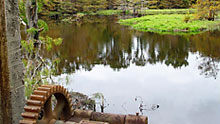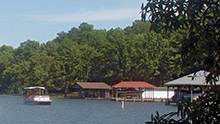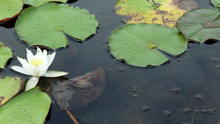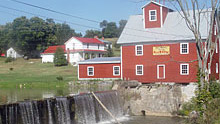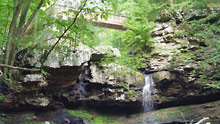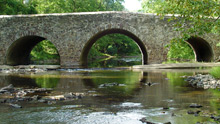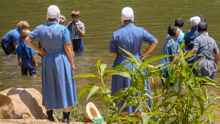Goniobasis or Elimia doolyensis
> Habitat & Distribution
The range of P. curvicostata was given by Chambers (1990) as "extending from tributaries of the Chattahoochee/Apalachicola west through the Yellow and Choctawhatchee systems to the Escambia of FL/AL," noting as he did that the evolutionary relationship between curvicostata populations and pleurocerid populations with similarly smooth shells in the Alabama River drainage deserves investigation. Our observations in the Georgia Gulf drainages concur with those of Chambers - confirming many curvicostata populations in tributaries of the Flint, Chattahoochee, and Apalachicola, none further east. Such populations reach maximum densities in smaller rivers and streams with good current, on mixed substrates, as is typical for the Floridian pleurocerids. FWGNA incidence unranked.
> Ecology & Life History
Grazing by populations of pleurocerids can have a significant effect on energy flow in small streams (Dillon 2000: 86 - 91, see also Dillon & Davis 1991).
Like other pleurocerids, P. curvicostata is dioecious, eggs being deposited on hard substrates from spring to mid-summer. Eggs are spirally arranged in masses of 2-15 or more, with a tough, membranous outer covering to which sand grains typically adhere (Smith 1980, Jokinen 1992). Although we are unaware of any study specifically directed toward the life history of P. curvicostata, it seems reasonable to expect that two years will be required for maturity, and that several years of iteroparous reproduction can be expected thereafter, as is the case for pleurocerids generally (Dazo 1965). This is life cycle Hi of Dillon (2000: 156 - 162).
> Taxonomy & Systematics
The taxonomy of the Floridian pleurocerids has been in a state of constant churn since the region first opened to exploration in the mid-nineteenth century. Isaac Lea initiated the conversation with his (1840) Melania boykiniana and catenaria/catenoides, the English publisher Lovell Reeve (1860, 1861) answered with Melania floridensis, M. curvicostata, and several others, and Lea (1862, 1864) countered with inclinans, albanyensis, doolyensis, mutabilis, viennaensis, induta, and many more. Goodrich (1921, 1924, 1942) added vanhyningiana, clenchi, and timidus, Clench & Turner (1956) responded with athearni and dickinsoni, and Mihalcik & Thompson (2002) added seven more species and subspecies to the Tower of Babble, all beneath further mention.
Genetic divergence at allozyme-encoding loci among populations of all these nominal species was well studied by Chambers (1978, 1980) throughout Florida and the Gulf drainages of Georgia. The single Chipola River population of P. curvicostata examined by Chambers (1980) was strikingly divergent genetically from all other Floridian species, and distinct by its shell morphology. Hence the species was lightly-treated by him in his review of 1990. He listed doolyensis (Lea 1862), viennaensis (Lea 1862) and induta (Lea 1862) as junior synonyms of curvicostata (Reeve 1861).
Mihalcik & Thompson (2002) reported relatively modest CO1 sequence divergence among seven individual P. curvicostata sampled from six different populations in four counties of Georgia and Florida.
The population genetic survey of Dillon & Robinson (2011) included a control sample of Chambers' P. curvicostata from the Chipola River (unpubl) as well as samples of viennaensis and induta from their type localities. Our data revealed that viennaensis is a junior synonym of catenaria (Say 1822) and that induta is best recognized as a subspecies of floridensis (Reeve 1860).
The diploid numbers of several Floridian pleurocerid populations have been reported as 2N = 36 (Chambers 1982, Dillon 1989, 1991).
All of these pleurocerid species have travelled through three genera in thirty years. Although predominantly assigned to Goniobasis through most of the 20th century, in the 1980s many workers began placing Goniobasis under the resurrected generic nomen, "Elimia." Both Goniobasis and Elimia were subsumed under Pleurocera by Dillon (2011). See my essay of 23Mar11 from the link below for more.
> Maps and Supplementary Resources
> Essays
- Taxonomic controversy has surrounded the generic nomina Pleurocera, Goniobasis, and Elimia for many years. The best entry into the subject would be my essay of 23Mar11, entitled Goodbye Goniobasis, Farewell Elimia. Links are available from that essay to older resources.
- I reviewed the tortured taxonomic history of P. floridensis in a pair of companion pieces, "Fred Thompson, Steve Chambers, and the Pleurocerids of Florida" (15Feb17) and "Fred Thompson, Elizabeth Mihalcik, and the Pleurocerids of Georgia" (14Mar17).
> References
Chambers, S. M. (1978) An electrophoretically detected sibling species of "Goniobasis floridensis" (Mesogastropoda: Pleuroceridae). Malacologia 17: 157-162.
Chambers, S. M. (1980) Genetic divergence between populatons of Goniobasis (Pleuroceridae) occupling different drainage systems. Malacologia 20: 63 - 81.
Chambers, S. M. (1982) Chromosomal evidence for parallel evolution of shell sculpture pattern in Goniobasis. Evolution 36: 113-120.
Chambers, S. M. (1990) The genus Elimia (= Goniobasis) in Florida (Prosobranchia: Pleuroceridae). Walkerana, 4, 237-70.
Clench, W. J. & R. D. Turner (1956) Freshwater mollusks of Alabama, Georgia, and Florida from the Escambia to the Suwannee River. Bull. Florida State Museum 1: 94 - 239.
Dazo, B. C. (1965) The morpholoogy and natural history of Pleurocera acuta and Goniobasis livescens (Gastropoda: Cerithiacea: Pleuroceridae). Malacologia 3: 1 - 80.
Dillon, R., T. Jr. (1989) Karyotypic evolution in pleurocerid snails: I. Genomic DNA estimated by flow cytometry. Malacologia, 31: 197-203.
Dillon, R., T. Jr. (1991) Karyotypic evolution in pleurocerid snails: II. Pleurocera, Goniobasis and Juga. Malacologia 33: 339 - 344.
Dillon, R. T., Jr. (2000) The Ecology of Freshwater Molluscs. Cambridge, Cambridge University Press. 509 pp.
Dillon, R. T., Jr. (2011) Robust shell phenotype is a local response to stream size in the genus Pleurocera (Rafinesque, 1818). Malacologia 53: 265-277.
Dillon, R. T. Jr., & K. B. Davis (1991) The diatoms ingested by freshwater snails: temporal, spatial, and interspecific variation. Hydrobiologia 210: 233-242.
Dillon, R. T., Jr. & Robinson, J. D. (2011) The opposite of speciation: Genetic relationships among populations of Pleurocera (Gastropoda: Pleuroceridae) in central Georgia. Am. Malac. Bull. 29: 1 - 10.
Goodrich, C. (1921) Three news species of Pleuroceridae. Occasional papers of the Museum of Zoology University of Michigan 91: 1 5.
Goodrich, C. (1924) Some old pleurocerids and a new one. The Nautilus 38: 43 48.
Goodrich, C. (1942) The Pleuroceridae of the Atlantic coastal plain. Occas. Pprs. Mus. Zool. Univ. Mich., 456, 1-6.
Hanley, R.W. & G.R. Ultsch (1999) Ambient oxygen tension, metabolic rate, and habitat selection in freshwater snails. Archiv fur Hydrobiologie 144:195-214.
Jokinen, E.H. (1992) The freshwater snails of New York State. New York State Museum Biological Survey, New York State Museum Bulletin 482.
Lea, Isaac (1840) Descriptions of new fresh-water and land shells. Proceedings of the American Philosophical Society 1: 284 -289.
Lea, Isaac (1862) Description of a new genus (Goniobasis) of the family Melanidae and eighty-two new species. Proceedings of the Academy of Natural Sciences of Philadelphia 14: 262 - 272
Lea, Isaac (1864) Descriptions of eleven new indigenous species of Melanidae. Proceedings of the Academy of Natural Sciences of Philadelphia 16: 3 5.
Mihalcik, E. R. & F. G. Thompson (2002) A taxonomic revision of the freshwater snails referred to as Elimia curvicostata, and related species. Walkerana 13: 1 - 108.
Reeve, L. A. (1860, 1861). Monograph of the genus Melania. In: Conchologia Iconica, or, illustrations of the shells of molluscous animals, vol. 12. L. Reeve & Co., London.
Thompson, F.G. (1999) An identification manual for the freshwater snails of Florida. Walkerana 10: 1 96.
Smith, D.G. (1980) Goniobasis virginica (Gastropoda: Pleuroceridae) in the Connecticut River USA. Nautilus 94:50-54.

